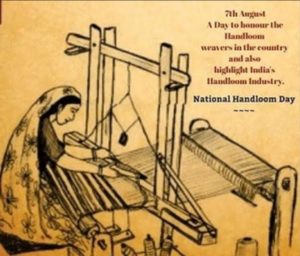Brief about National Handloom Day
National Handloom Day is a momentous occasion that pays tribute to the vibrant heritage of handloom weaving in India. Celebrated annually on August 7th, this day serves as a reminder of the rich cultural significance and artistic finesse of handloom textiles. It commemorates the Swadeshi Movement launched in 1905, which aimed to promote and support indigenous products, particularly handwoven fabrics, and foster a sense of national pride. On this auspicious day, we honor the skilled artisans and their time-honored craftsmanship, while also highlighting the importance of sustaining this traditional art form for generations to come.
Table of Contents

History of National Handloom Day
National Handloom Day is observed in India on August 7th each year to celebrate the rich cultural heritage of handloom weavers and promote their craftsmanship. The day was inaugurated by the Indian government in 2015, with the aim of encouraging the use of handloom products and supporting the livelihoods of weavers across the country.
The date, August 7th, was chosen to honor the historic Swadeshi Movement that took place on this day in 1905. During the Swadeshi Movement, which was a part of India’s struggle for independence, Mahatma Gandhi urged the people to use and promote indigenous products, including handloom textiles, to reduce dependence on imported goods and support the local economy.
Since its inception, National Handloom Day has become an important occasion to raise awareness about the significance of handloom weaving and the need to preserve traditional techniques. It also serves as a platform for showcasing the exquisite artistry of handloom products and fostering a sense of national pride in India’s rich weaving heritage.
Why To Celebrate National Handloom Day
National Handloom Day is celebrated to promote and celebrate the rich heritage of handloom weaving in India. It was established on August 7th to commemorate the Swadeshi Movement, which was launched in 1905 to promote indigenous products and protest against British colonial rule. By celebrating this day, the government aims to recognize the efforts of handloom weavers and artisans, preserve traditional weaving techniques, and encourage the use of handloom products, thereby supporting the handloom industry and empowering local communities.
How To celebrate National Handloom Day
National Handloom Day provides an opportunity to support local artisans, promote sustainable practices, and preserve age-old traditions.
Wear Handloom Fabrics with Pride:
On this special day, make a conscious effort to wear clothing made from handloom fabrics. Sarees, kurta, dupattas, and stoles woven with intricate designs and vibrant colors showcase the skill and artistry of Indian weavers.
Purchase Handloom Products:
Show your support for local weavers and artisans by purchasing handloom products. From clothing to home furnishings like bedspreads, tablecloths, and rugs, handloom items offer unique designs and superior quality.
Organize Handloom Workshops and Exhibitions:
Celebrate National Handloom Day by organizing workshops and exhibitions that showcase the art of handloom weaving. Collaborate with local artisans to demonstrate their techniques, share stories of their craft, and provide visitors with hands-on experiences.
Educate and Raise Awareness:
Take the opportunity to educate others about the historical significance of handloom weaving in Indian culture.
Support Social Initiatives:
Many non-profit organizations and government initiatives work towards uplifting the lives of handloom weavers. Support these social initiatives by contributing donations or volunteering your time to assist in their programs.
Collaborate with Designers:
Encourage collaborations between handloom weavers and contemporary designers. These partnerships can create fusion designs that appeal to a wider audience while preserving the essence of traditional handloom techniques.
National Handloom Day is celebrated on August 7th in India to commemorate the Swadeshi Movement, which was launched on the same day in 1905. This movement aimed to promote the use of indigenous handloom fabrics and support the country’s rich textile heritage.
Significance Of National Handloom Day
The significance of National Handloom Day lies in promoting and preserving traditional handloom weaving techniques and the livelihoods of millions of artisans involved in the handloom sector. It raises awareness about the cultural importance and economic value of handloom products, encouraging people to support the handloom industry by purchasing handcrafted textiles.
By celebrating this day, India seeks to foster a sense of pride in its diverse handloom traditions and create a sustainable market for handloom products both domestically and globally. It also serves as a reminder of the importance of preserving the artistry, skills, and cultural legacy of handloom weaving for future generations.
Conclusion
In conclusion, National Handloom Day holds great significance as a commemoration of India’s rich textile heritage and the Swadeshi Movement. It serves as a platform to promote and preserve traditional handloom weaving techniques and support the livelihoods of countless artisans involved in the handloom sector. By celebrating this day, India aims to raise awareness about the cultural and economic value of handloom products, encouraging people to cherish and support the country’s diverse handloom traditions. Ultimately, National Handloom Day emphasizes the importance of preserving the artistry, skills, and cultural legacy of handloom weaving for the benefit of present and future generations.
Click on the following link
